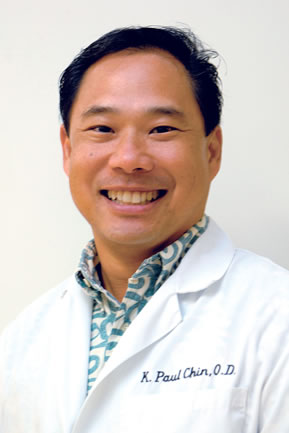Moistening Those Dry Eyes
Dr. K Paul Chin
Optometrist
Interviewed By Rasa Fournier
Where did you receive your schooling and training?
I went to the University of Miami for undergraduate, then to Southern College in Memphis, Tenn.
How long have you been practicing?
For 21 years.
How often do people come to you for help with dry eyes?
Statistically, 35 percent of my patients have dry eyes, and it’s more common and gets worse as you get older. I see dry eyes every day. It’s particularly prevalent among females, especially over the age of 35, because of hormonal changes. But there’s new prescription medications and tons of over-the-counter medications for dry eyes.
What causes the dryness?
Aging, low humidity in winter and contact lens wear.
Because of Hawaii’s humidity, do we tend to have less of a dry eye problem than most places?
Desert areas like Arizona tend to have more of a problem. It still gets pretty bad in Hawaii. The demographic that has it worst is Northern Europeans. A lot of people self-medicate, but there’s more than over-the-counter eye drops. There’s a whole armamentarium of ways to help dry eyes.
Are dry-eye symptoms readily recognizable or do people sometimes not realize what they’re suffering from?
The symptoms, typically, are sandy, gritty, grainy, red eyes. What people don’t often realize is that one of the biggest symptoms of dry eyes is wet, teary eyes because you get reflex tearing. Your eyes are dry, so you get reflex tearing and then they dry out again. People will come in and be surprised when I tell them they have dry eyes. They’ll say I have excessive tearing, how can I have dry eyes?
What treatments are available?
We start with over-the-counter medications and then we put them on various drops, with a thicker, higher viscosity. We can also put plugs in their eyes. They are little, silicone plugs that go into your upper or lower lid and they keep the tears in your eyes longer.
Are the plugs visible?
They go in the tear duct, so they’re hidden.They’re permanent, but, actually, removable. If someone doesn’t want the more-permanent type, we have temporary ones that will last anywhere from a week to a month.
Wouldn’t the plug end up blocking tears from entering the eye?
Tears come from around your eye, under your lids. The tear drainage system is an active pump. It doesn’t just drain. When you blink, there’s a bladder that opens and pulls the tears into the ducts.
Having plugs in the tear duct actually keeps the tears in your eyes longer. It blocks the drainage, so you get a bigger tear lake. It’s good for allergies too because it prevents allergens from going into the sinuses.
Do you still need drops if you have the plug?
I get the whole gamut from “I stopped using all my drops,” to “I reduce the amount of drops I put in.” I also get some who say the plug didn’t help one bit, but usually it’s somewhere in between.
Anything else you’d like to mention about dry eyes?
There’s a drug called Restasis. It’s the only FDA-approved drug for dry eyes, and it does work. It’s used twice a day. A lot of people are suffering out there, and they don’t know there’s help for their dry eyes. A lot of times they end up getting help by happenstance. They come in for a regular eye exam and they go “By the way …” It turns out fitting them for glasses is the lesser problem and that the dry eyes has been causing them suffering for years. Working with dry eyes doesn’t take rocket science, but it’s something that in everyday life makes a difference in comfort. Even with a simple thing like watching TV at night, it can help.
People should get checked at least once a year for proper eye health. Dry eyes is really a buzz topic lately. When I go to meetings, it’s pretty common that it’s about dry eyes. But treating it really makes a difference for people.
On the topic of eye comfort, we also have anti-reflection glasses that reduce glare if you’re on a computer a lot. It makes it more comfortable for the eyes. For people who wear prescription glasses, we actually put it right on the glasses. A lot of the celebrities wear them now as well. Take a look at local newscasters who wear glasses if you look closely, you’ll see there’s no glare coming from their eyeglass lenses and it may actually look like there aren’t any lenses in their frames.
Changing the topic a bit, what’s the best way to deal with pinkeye (conjunctivitis)?
Winter is the season when we see the most pinkeye cases. It is a viral infection of the transparent membrane covering the eye, called the conjunctiva. The symptoms are a pinkish, reddish eye with sticky tears, and it usually lasts five to seven days. It is contagious, so we urge the affected person to use proper hygiene such as washing their hands frequently and to avoid touching their eyes with dirty hands that’s probably how they got it in the first place. The good news is that most cases of pinkeye are minor, but it is always a good idea to follow up with your optometrist.







